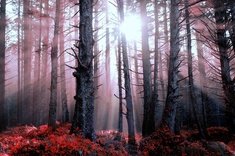|
Hint
|
Answer
|
|
This area is home to at least 14 of the uncontacted tribes, and is one of the most isolated places in the world. An estimated 2000 indigenous people live autonomously from the government in an area about the size of Austria.
|
Brazil -Vale do Javari
|
|
Home to temperate rainforests, glaciers, fjords, and hot springs, this area is one of the earh's wildest landscapes. It’s the country’s most sparsely populated region and has only been accessible by highway since the 1980s. The field in this area remains one of the largest masses of ice outside the polar regions.
|
Chile - Northern Patagonia
|
|
This eastern peninsula of this country is home to some of the most spectacular volcanic activity on earth, with more than 300 volcanoes, including one that has been erupting continuously since 1996. It’s home to the most densely populated brown bear habitat in the world. This vast territory is around the size of California.
|
Russia - Kamchatka
|
|
Located off the eastern coast of this country, scientists didn’t delve into this submarine trench until 2013. When researchers sent underwater robots into this crack in the ocean floor almost four and a half miles deep, they found prawns and eels totally unlike those found in other deep-sea trenches.
|
Australia - New Hebrides Trench
|
|
Many of the subtropical forests located on the steep slopes of the easternmost stretch of the highest mountain range on earth are virtually untouched by human activity. Deep within the forests of this country lies the largest tiger preserve in the world. It’s also home to bears, red pandas, and gibbons.
|
Myanmar - Northern Forest Complex
|
|
Named for the unique and massive limestone formations along the western edge of this island nation, this 600-square-mile national park and wilderness preserve is a labyrinth of jagged, needle-shaped limestone. Gorges, canyons, and forests are a natural home to a huge number of species of plants and animals not found anywhere else on earth. While the southern tip of this presere is open to the public, much of the reserve is off-limits to tourists.
|
Madagascar - Tsingy de Bemaraha National Park
|
|
Estimated to be the world’s oldest desert, this area of this country is one of the driest, least-populated places in the world. Dunes dominate this harsh desert, and there are few paved roads. At 1256 feet tall, the giant Dune 7 is believed to be the tallest sand dune in the world.
|
Namibia - Southern Namib Desert
|
|
This remote region in the western part of this country contains the Hindenburg Wall, a limestone network of plateaus more than a mile high. The 30-mile-long series of bluffs features nearly undisturbed ecosystems high above the ground. A 2013 biological survey of the area found 1,108 animal and plant species, almost 100 of which were new to science.
|
Papa New Guinea -Star Mountains
|
|
|
Hint
|
Answer
|
|
This area spans a territory about the same size as India, with a large swath of the territory located above the Arctic Circle. Its climate is one of the world’s most extreme: Average temperatures in January are as low as -33 °F, and most of the land is covered by permafrost.
|
Russia -Skaha Republic
|
|
This island territory of this country was first visited by Vikings around 1000 AD, we’re still discovering parts of the far-northern region, and melting glaciers continue to reveal new islands. Much of the inland part of the country is still uninhabited, as roughly 80 percent of the island is covered by ice cap.
|
Denmark - Greenland
|
|
This almost 8000-foot-tall peak is the largest of a series of mountains with very different species making their homes on the surrounding peaks. In 2014, a group of biologists and rock climbers teamed up to conduct fieldwork in the region, where rock climbing was sometimes the only way to get to unexplored habitats.
|
Mozambique - Mount Namuli
|
|
In this country's largest national park, glaciers contain some of the country’s oldest rocks. The vast wilderness is home to a unique diversity of animals, like the takahē, a flightless indigenous bird thought to be extinct for decades until it was rediscovered in the park in 1948, and the kākāpō, the world’s only flightless, nocturnal parrot. The area's 2.9 million acres are some of the wildest lands in the Southern Hemisphere.
|
New Zealand -Fiordland National Park
|
|
Walled off by forbidding granite boulders piled hundreds of feet high, this area is only around 900 miles from one of the nation’s biggest cities. However, this rainforest habitat might as well be a world away. Virtually inaccessible except by helicopter, scientists discovered three completely new species of animals in the area in 2013.
|
Australia -Cape Melville
|
|
The world’s largest cave contains its own river and even a jungle. At more than 5.5 miles long, it’s cavernous enough to house a skyscraper. The first expedition set off to explore this underground world in 2009 before being stymied by a 200-foot-tall wall of calcite inside. Much of the surrounding network of over 150 caves remains unsurveyed and unexplored.
|
Vietnam -Son Doong Cave
|
|
Located off the southernmost tip of another country this island has seen few outsiders, and there’s a three-mile exclusion zone surrounding the island, where somewhere between 50 and 300 people are estimated to live. The locals’ hostile reactions to outsiders' attempts at contact have left much of the island unexplored.
|
India -North Sentinel Island
|
|

